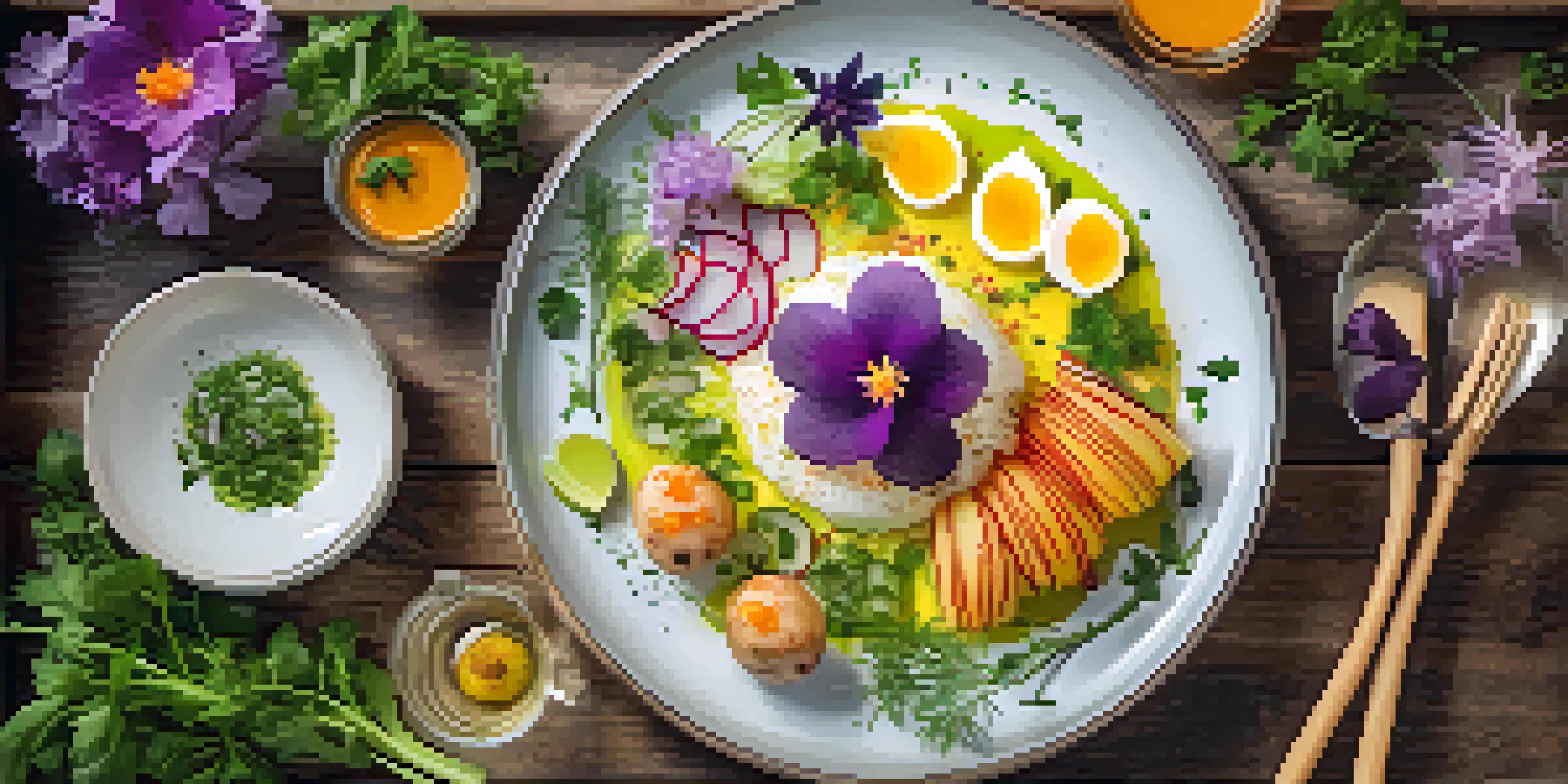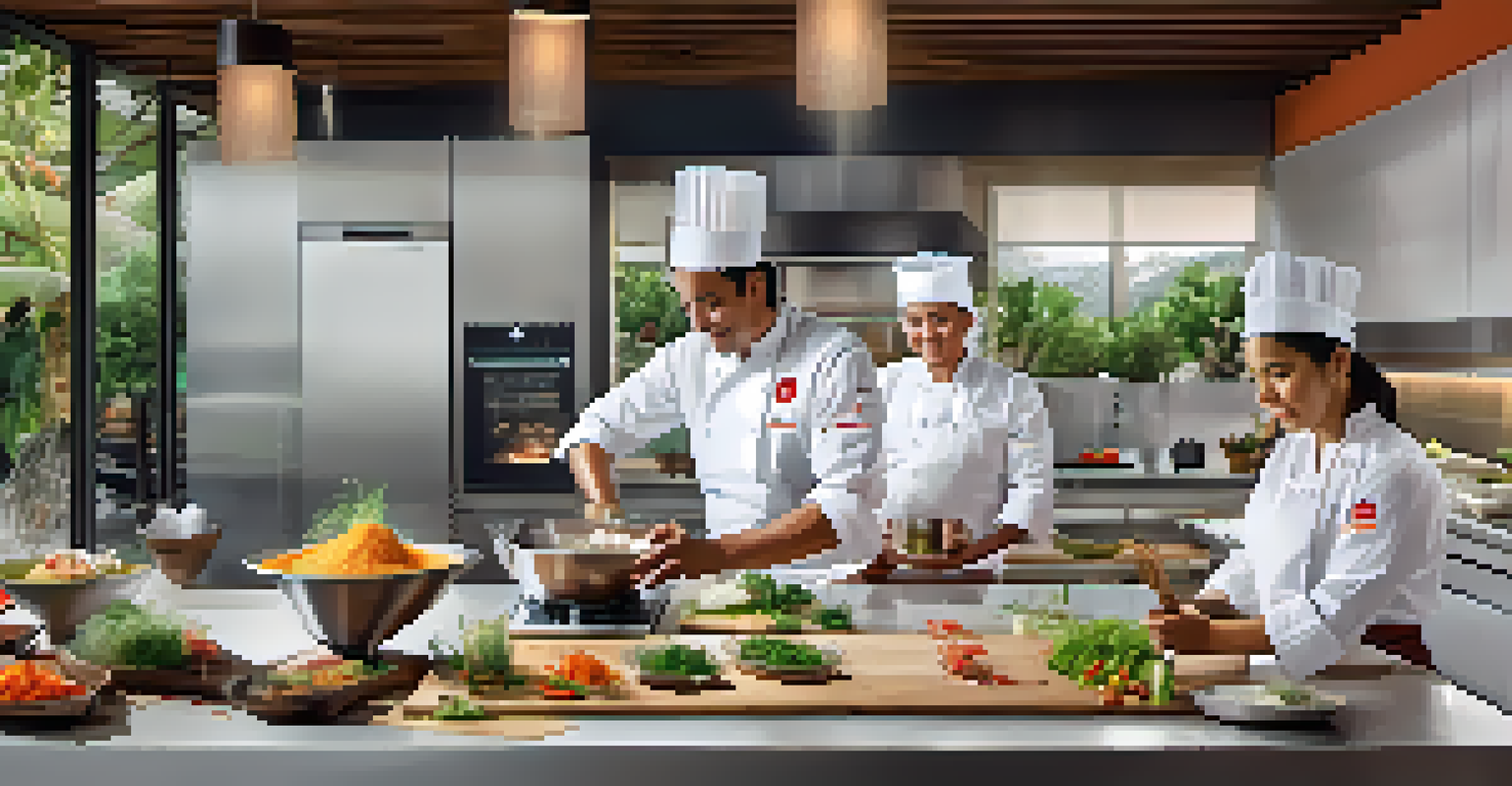Traditional Ingredients Meet Modern Techniques in Peru

The Rich Tapestry of Peruvian Cuisine
Peruvian cuisine is a vibrant mix of flavors and cultures, shaped by its diverse geography and rich history. From the Andes mountains to the Amazon rainforest, each region contributes unique ingredients, creating a culinary landscape that is both varied and exciting. Traditional staples like potatoes, corn, and quinoa form the foundation of many dishes, while coastal influences add a depth of seafood flavors.
Cooking is like love. It should be entered into with abandon or not at all.
This melting pot of traditions has given rise to a culinary renaissance in Peru, where ancient practices meet contemporary cooking methods. Chefs are now experimenting with these traditional ingredients, marrying them with modern techniques to elevate their dishes to new heights. It's a celebration of heritage, innovation, and the incredible bounty of Peru's land.
In essence, the evolution of Peruvian cuisine reflects the country's commitment to honoring its roots while embracing change. Diners are treated to a gastronomic experience that not only tantalizes the taste buds but also tells a story of cultural identity and pride.
Highlighting Key Traditional Ingredients
At the heart of Peruvian cuisine are its key traditional ingredients, each with a unique flavor and nutritional profile. Potatoes, for instance, come in over 4,000 varieties in Peru, making them a versatile ingredient that can be boiled, fried, or mashed. Meanwhile, corn is not just a side dish; it's the star of many recipes, including the beloved tamales and chicha, a traditional fermented beverage.

Quinoa, often hailed as a superfood, has deep roots in Andean culture and is celebrated for its high protein content. Chefs are now using quinoa in innovative ways, incorporating it into salads, desserts, and even as a crust for meats. These ingredients showcase the connection between Peru's agricultural heritage and its culinary innovation.
Culinary Fusion Enhances Tradition
Peruvian cuisine beautifully blends traditional ingredients with influences from around the world, creating innovative dishes that reflect the country's rich cultural tapestry.
By highlighting these traditional ingredients, chefs not only preserve their cultural significance but also introduce them to a global audience. This fusion of old and new invites both locals and tourists to explore the depth of flavors Peru has to offer.
Modern Cooking Techniques Transforming Tradition
Modern cooking techniques have revolutionized the way traditional ingredients are prepared and presented in Peru. Techniques such as sous-vide, fermentation, and molecular gastronomy are being used to enhance flavors and textures while maintaining the essence of the original ingredients. For example, sous-vide cooking allows chefs to cook meats to perfection, ensuring they remain tender and flavorful.
Food is our common ground, a universal experience.
Fermentation, a technique that has been used for centuries, is experiencing a resurgence in Peru. Chefs are experimenting with traditional fermentation methods to create unique condiments and sauces that elevate their dishes. This not only adds complexity but also honors the age-old practices that have shaped Peruvian cuisine.
These modern techniques do not overshadow the traditional roots; rather, they complement them, allowing chefs to express their creativity while respecting the ingredients' heritage. The result is a harmonious blend that excites the palate and captivates the senses.
The Role of Local Chefs in Culinary Innovation
Local chefs play a pivotal role in the evolution of Peruvian cuisine, acting as both custodians of tradition and pioneers of innovation. Many chefs have traveled internationally, bringing back new ideas and techniques that they incorporate into their cooking. This exchange of knowledge fuels a vibrant culinary scene that continuously evolves while staying true to its roots.
Chefs like Gastón Acurio and Virgilio Martínez have become ambassadors of Peruvian cuisine on the global stage, showcasing how traditional ingredients can be transformed through modern techniques. Their restaurants serve as platforms for experimentation, where local flavors meet international culinary trends, creating dishes that are both familiar and surprising.
Sustainability is Key in Cooking
Chefs in Peru are prioritizing sustainable practices by sourcing local ingredients and incorporating seasonal produce, which enhances flavor while benefiting the environment.
By championing local ingredients and sustainable practices, these chefs are not only redefining Peruvian cuisine but also inspiring a new generation of cooks. Their commitment to innovation while honoring tradition encourages a rich culinary culture that resonates with both locals and visitors alike.
Fusion Cuisine: Bridging Cultures Through Flavor
Fusion cuisine in Peru is a testament to the country's rich cultural tapestry, blending traditional Peruvian ingredients with influences from Asian, European, and African cuisines. This culinary cross-pollination has led to the creation of unique dishes that reflect the diverse heritage of the nation. For instance, the popular dish 'Chifa' combines Chinese cooking techniques with Peruvian ingredients, resulting in flavorful stir-fries and rice dishes.
Dishes like 'Causa Limeña,' a layered potato dish, have also seen variations that incorporate international elements, showcasing how adaptable and versatile Peruvian cuisine can be. This fusion not only broadens the culinary landscape but also fosters a sense of community among cultures, bringing people together through the love of food.
As chefs continue to explore and innovate, the possibilities for fusion cuisine are endless. This creative approach not only enhances the dining experience but also highlights the importance of cultural exchange in shaping modern culinary practices.
Sustainable Practices in Modern Peruvian Cooking
Sustainability is becoming increasingly important in the culinary world, and Peru is leading the charge by prioritizing sustainable practices in its kitchens. Many chefs are sourcing ingredients locally, supporting farmers and communities while minimizing their carbon footprint. This commitment to sustainability not only benefits the environment but also ensures the freshness and quality of the ingredients used in their dishes.
Incorporating seasonal produce into menus is another way chefs are promoting sustainability. By using ingredients that are in season, they not only enhance the flavors of their dishes but also reduce waste. This practice encourages a deeper connection between chefs and the land, fostering a sense of responsibility for the ingredients they use.
Modern Techniques Transform Dishes
The use of modern cooking techniques, such as sous-vide and fermentation, allows chefs to elevate traditional Peruvian ingredients while honoring their culinary heritage.
Sustainable practices in Peruvian cuisine reflect a growing awareness of the impact of food choices on the planet. As more chefs embrace these principles, they are paving the way for a more conscious dining culture that values both flavor and environmental stewardship.
The Future of Peruvian Cuisine: A Culinary Adventure
The future of Peruvian cuisine looks bright, with chefs continuously pushing the boundaries of creativity and innovation. As traditional ingredients meet modern techniques, the culinary landscape is ever-evolving, inviting diners to embark on a flavorful adventure. This dynamic environment encourages experimentation and exploration, making each dining experience in Peru a unique journey.
With an increasing number of international chefs taking an interest in Peruvian ingredients and cooking methods, the potential for global influence is significant. As these culinary exchanges continue, the world can expect to see a rising appreciation for Peruvian flavors and techniques, further solidifying its place on the global culinary map.

Ultimately, the fusion of tradition and modernity in Peruvian cuisine tells a story of resilience, creativity, and cultural pride. It invites everyone to savor a piece of Peru's rich heritage while embracing the exciting possibilities that lie ahead in the culinary world.